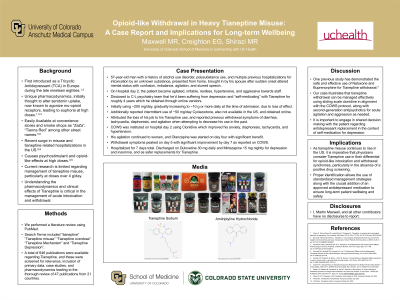Psychopharmacology and Toxicology
(146) Opioid-like Withdrawal in Heavy Tianeptine Misuse: A Case Report and Implications for Long-term Wellbeing


Martin R. Maxwell, Jr., MSW, LCSW (he/him/his)
Medical Student
University of Colorado School of Medicine
Fort Collins, Colorado
Elizabeth Garcia Creighton, BA
Medical Student
University of Colorado School of Medicine
Fort Collins, Colorado
Matthew R. Shirazi, MD
Assistant Clinical Professor of Psychiatry, Consultation-Liaison Psychiatrist
University of Colorado School of Medicine, Colorado State University Campus
Fort Collins, Colorado
Presenting Author(s)
Co-Author(s)
Background/Significance:
Tianeptine, an atypical antidepressant with opioid-like effects, has recently seen a surge in misuse in the US, yet information is limited regarding management of tianeptine misuse, particularly at doses over 4 g. We present the case of a 57-year-old man hospitalized for altered mental status and agitation, reporting use of 10 g of tianeptine daily.
Case:
A 57-year-old man with a history of alcohol use disorder, depression, and polysubstance use disorder was hospitalized for altered mental status with imbalance, slurred speech, and confusion, reporting daily use of up to 10 g of tianeptine. The patient's urine drug screen was positive only for benzodiazepines, and he had a negative blood alcohol level. Upon presentation he had hypertension, with irritability, restlessness, and aggression towards hospital staff. He reported fear of withdrawal symptoms if stopping tianeptine use, including diarrhea, tachycardia, diaphoresis, and agitation—all of which were observed during hospitalization. The patient was admitted for seven days total, and the COWS (Clinical Opioid Withdrawal Scale) protocol was instituted for safe withdrawal on day three, utilizing clonidine for withdrawal and olanzapine for agitation. His symptoms peaked on day five with significant improvement by day seven, and he was discharged with no psychomotor agitation or aggression. Duloxetine and mirtazapine were initiated for long-term treatment of his depression and insomnia, and as safer replacements for tianeptine.
Discussion:
Tianeptine has no FDA approval, yet there has been an exponential increase in its misuse in the past decade for its psychostimulant and opioid-like effects at high doses, and its availability online and in convenience stores (Edinoff et al., 2023; Rushton et al., 2021). Current literature on tianeptine withdrawal is limited, with only one article reporting doses above 5 g/day, demonstrating the safe and effective use of Naloxone and Buprenorphine in this context (Rawal et al., 2023). Our case additionally illustrates that tianeptine withdrawal can be managed effectively using sliding scale clonidine, in alignment with the COWS protocol, along with second-generation antipsychotics for acute agitation and aggression.
Conclusions/Implications:
As tianeptine misuse continues to rise in the US, it is imperative that physicians consider tianeptine use in their differential for opioid-like intoxication and withdrawal syndromes in the absence of a positive drug screening. Proper identification will allow the use of standardized management strategies, along with the crucial addition of an approved antidepressant medication to ensure long-term patient wellbeing.
References:
Edinoff, A.N., Sall, S., Beckman, S.P., Koepnick, A.D., Gold, L.C., Jackson, E.D., Wenger, D.M., Cornett, E.M., Murnane, K.S., Kaye, A.M., Kaye, A.D., 2023. Tianeptine, an Antidepressant with Opioid Agonist Effects: Pharmacology and Abuse Potential, a Narrative Review. Pain Ther. 12, 1121–1134. https://doi.org/10.1007/s40122-023-00539-5
Rawal, V.Y., Gallardo, M., Henderson, K., Hall, O.T., Klisovic, N., Sikic-Klisovic, E., 2023. Severe tianeptine withdrawal symptoms managed with medications for opioid use disorder: a case report. J. Addict. Dis. 1–6. https://doi.org/10.1080/10550887.2023.2290139
Rushton, W., Whitworth, B., Brown, J., Kurz, M., Rivera, J., 2021. Characteristics of tianeptine effects reported to a poison control center: a growing threat to public health. Clin. Toxicol. 59, 152–157. https://doi.org/10.1080/15563650.2020.1781151
Presentation Eligibility: Not previously published or presented
Diversity, Equity, and Inclusion: Individuals presenting with tianeptine misuse present a unique challenge given a potentially greater risk for co-morbid substance use disorders and depression, such as in our case presentation. Treating this withdrawal syndrome as a traditional opioid withdrawal alone, without adequate depression screening and long-term antidepressant use could marginalize patients with these co-morbidities. Our paper encourages a more wholistic approach to acute and long-term management. Additionally, our panel members have a demonstrated commitment to diversity, equity, and inclusion through published works advancing these causes, and providing mental health care for indigent populations.

